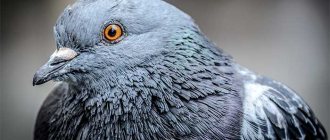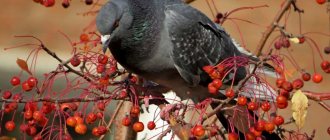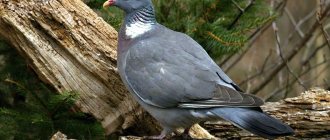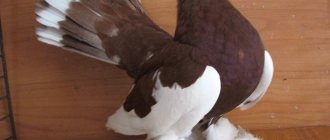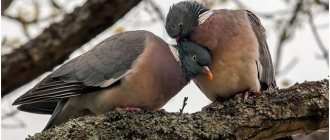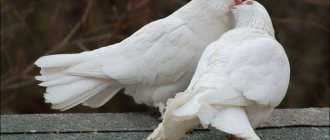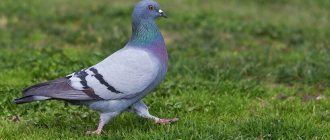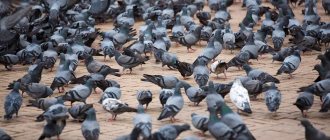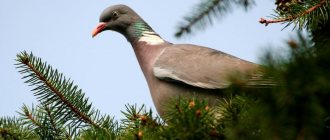Appearance
Rock pigeons are rather large birds, they grow up to 37-40 cm and weigh 230-400 g. But among them there are dwarf individuals whose body length does not exceed 29 cm. Although rock pigeons give the impression of being quite slender birds, they have an impressive reserve of subcutaneous fat .
In general, all representatives of this species fit the following description:
- Head. Small, with ears almost invisible under the plumage and a blunt beak, rounded to the tip, at the base of which there is a dense white wax.
- Eyes. Yellow or golden color. Occasionally among sisars there are individuals with an orange or red iris.
- Body. Elongated, with a short neck. The crop is marked by bright plumage.
- Wings. Strong, long, with a wide base and pointed tips. The flight feathers have thin black stripes. The wingspan of the rock pigeon is 65-72 cm.
- Tail. 13-14 cm long with a rounded tip and black edging on the feathers.
- Paws. Short, colored black or pink. Sometimes partially covered with feathers.
Find out in a separate article - “All about pigeons.”
Wild sisars are gray-blue in color. These birds are easily distinguished by their light gray wings with a pair of large black stripes and a snow-white spot on their back. As a result of artificial selection, in addition to the natural “wild” colors, these pigeons now have more than 25 color options.
Most often found in urban environments are white, black, coffee-brown and light red sisari. Moreover, on the body of the latter there may be single white feathers. The bird's crop is pinkish or wine-colored. And the plumage on the head, chest and neck has a yellow, violet-green or metallic pink tint.
On a note. The feather cover of young animals up to 6-8 months of age looks dull. The characteristic glossy shine of rock pigeons appears after the first molt.
general characteristics
Pigeons are small birds that, depending on the variety, can grow from 15 to 75 cm. Their weight varies from very small (about 30 grams) to large - 3 kg. The birds' physique is quite muscular and strong. Their neck is short and their head is small. In comparison, the wings are quite long and wide-opening. The flight feathers are round at the ends.
City pigeons, which are most often encountered by people, usually measure about 35 cm and weigh up to 40 grams.
The tail is also quite long and grows in proportion to the body. It can be sharp, round or wide. Pigeons usually have about 13 tail feathers, but in crowned varieties this number can reach 18 feathers.
The beak of pigeons is usually short, but sometimes is of medium length. It is straight and thin, with a widening at the base.
Pigeons do not have pronounced sexual dimorphism: males and females do not differ in color or other external characteristics. Moreover, males are slightly larger than females. However, in some tropical bird species, the males have brighter colors.
The plumage of the birds itself is quite thick, it fits tightly to the body and combines several shades. Birds are very diverse, so color options may vary depending on their habitat. So, they can be single-colored (gray, yellow, white, etc.), variegated, or have a pattern on the plumage.
The paws of pigeons are four-toed, which makes them extremely convenient for terrestrial movement. The legs are quite short: three toes are located in front, one is behind. This helps pigeons move easily on the ground, which distinguishes them from, for example, sparrows, which have to move by jumping.
Due to their anatomical structure, pigeons are capable of reaching high speeds - more than 130 km/h. Even ordinary birds found in the city are considered strong and hardy. They fly at a speed of about 70 km/h. With such a flight, birds are able to cover significant distances, approximately 300 km per day.
Habitat
The range and distribution of rock pigeons affects almost all continents, with the exception of Antarctica. These birds spread most densely across Eurasia and Africa. Sisari settled down in the Altai Mountains, the Caucasus, Crimea and eastern India. Birds have chosen the Tien Shan mountain ranges and the lands from the Yenisei basin to the Atlantic.
Sisaris are found on the coasts of the Gulf of Aden and Darfur, as well as in some areas of Senegal. Small populations of rock pigeons live in the Mediterranean, Great Britain, Sri Lanka, the Faroe Islands and the Canary Islands.
Interesting! On some continents, the Sisari settled artificially. For example, they came to the lands of Nova Scotia (Canada) in 1606 thanks to the French.
Depending on the place of distribution, rock pigeons are of 2 types:
- Wild. These pigeons can be found in mountainous regions at an altitude of 2.5-3 km. They settle near grassy plains next to flowing bodies of water. Wild sisars nest in ravines, rock crevices and other secluded places where there are no people. Birds avoid dense forests and regions with a monotonous, open landscape.
- Synanthropic. These birds settle near industrial complexes and in areas near high-rise buildings. Within cities, rock pigeons live in gardens and parks, in busy squares, on the roofs of buildings and in destroyed buildings. In rural areas, flocks of these birds flock to the current where grain is ground and stored.
On a note. Urban rock pigeons settle where it is safe and convenient to build nests. With the onset of cold weather, birds move closer to people and often flock to garbage dumps.
Interesting Facts
This breed has such a feature as homing. This is the ability to return home from any distance. These birds can stay in the air for a long time. The record holder for returning home from a long distance is the dove Beauty of Brazil. She flew 41.5 km.
If you blindfold a bird, it will stop shaking its head back and forth and orienting itself in the area. Descriptions of pigeons are found in historical sources much more often than about other avian representatives.
Habits and lifestyle
Rock pigeons are sedentary birds. During daylight hours they fly in search of food. At night the sisari sleep. Females spend the night in the nest, and males stay nearby and protect their family. Although rock pigeons are very light sleepers, they ruffle their feathers, put their heads under their wings and sleep until dawn.
On a note. In modern megacities, the lifestyle of rock pigeons has changed a little. On well-lit streets, birds are often active even after sunset.
Sisaris spend up to 30% of their waking hours on flights. The main period of a bird's life is to walk on the ground and get food. Wild sisars are much more active than synanthropic pigeons. In search of food, they can travel 50 km from the nest.
According to ornithologists, rock pigeons navigate in space by sunlight and magnetic fields. Experts were able to prove that in urban areas, birds identify the area by buildings.
Pigeons communicate with each other by flapping their wings or calling each other. Scientists have identified several types of sisar cooing:
- in love;
- draft;
- repellent;
- nesting;
- stern
The cooing of rock pigeons is similar to a throaty purr. Most often it is produced by males. With its help, sisari attract females and scare away enemies.
Natural enemies of the rock-winged pigeon
The greatest danger to birds is from feathered predators. Most often, pigeons are attacked by hawks. They are most active during the breeding season. Hawks are especially dangerous for wild sizars.
Urban pigeons are more threatened by the peregrine falcon. It is a fast predator that often flies into the city to hunt pigeons.
Ordinary crows also have a negative impact on the pigeon population. They rarely attack adult birds, but are capable of destroying nests and eating chicks. If a crow is about to attack an adult, it will look for a weakened or elderly bird.
For reference! In addition to feathered predators, pigeons can suffer from attacks from martens, snakes and ferrets.
Nutrition
Rock pigeons are omnivorous and very voracious birds, capable of pecking up to 40 g of grain at a time with a daily norm of 60 g. But this only happens when there is an abundance of food, when the birds are in a hurry to eat for future use.
The basis of the birds' daily diet is grains, plant seeds, berries and fruits. Sisaris do not disdain mollusks, worms and insects. And to improve digestion, pigeons swallow sand, shells and small pebbles.
Interesting! The pickiness of rock pigeons is explained by the fact that they have only 37 taste buds.
In places where there is an abundance of food, entire flocks of pigeons can be observed. Massive concentrations of sisars are found in the fields during harvesting. There, birds peck weed seeds and grains that have fallen to the ground.
During the hungry period, rock pigeons begin to consume food that is uncharacteristic for them. To survive, birds eat frozen berries, sprouted oats and carrion. Sisaris look for food in city dumps, in trash cans, and even peck at dog droppings.
Find out - “What cereals can you feed pigeons.”
Breeding
To breed Rock Pigeons at home, you need to build a poultry house. The difference between the breed is its unpretentiousness in choosing food. However, this fact does not mean that you can leave the feeding of pigeons to chance. Beautiful feathers and tasty meat can only be obtained under conditions of proper care and feeding with balanced feed.
Pigeons have very weak immunity, so to avoid infection with infectious diseases they should be vaccinated. Pigeons can be carriers of many diseases that are dangerous to humans. Cleanliness and timely ventilation of the room in which pigeons live is the key to good health for pets. Also, the room must maintain optimal temperature and air humidity so that the birds can develop normally. There must be free range.
Reproduction
Rock pigeons become sexually mature at six months of age and mate for life. During the season they are able to raise 4-8 broods of chicks, not all of which survive. In regions with a favorable climate, birds breed all year round. And representatives of northern populations hatch chicks only during the warm period.
Before creating a pair, the male looks for a place to build a nest. Then the sisar looks for a partner who will suit his age and temperament. The pigeon spectacularly conquers the female it likes. He makes a loving coo, spreads his tail, dances and hugs his chosen one with his wings. But no matter how hard he tries, the final choice remains with the female. If she doesn’t like the gentleman, she will not reciprocate his advances.
Read more about “How pigeons reproduce.”
After creating a pair, the birds begin to build a nest. The male delivers building materials, and the female is engaged in arrangement. 12-14 days after mating, the dove lays eggs. The interval between the appearance of the first and second is 1-2 days. Sisars have white eggs with a smooth shell and a bluish or milky tint. They are small in size - no more than 20 mm in height. Both parents take turns incubating the eggs. This process takes on average 16-19 days.
Chicks are born at intervals of 10-48 hours. They hatch completely naked and need constant heating. Until 25 days of age, the chicks feed on milk, which is produced in the parental crops. Then the babies begin to eat soaked grains, which they pull out with their beaks from the mother’s or father’s throat.
By the age of one and a half months, the young animals acquire feathers and become similar to adult pigeons.
Nesting
When a pair is formed, the pigeon guards with particular zeal the territory where the nest is located, as well as its female. If another male appears, he tries to close the chosen one and take her away from him. The most aggressive ones start fights with strangers.
Females of this breed are always attached to one partner. Even when a bird is stolen or crossed with another male, it will still return to its old partner. The couple makes a nest together. The female sits and obediently waits for her partner to bring her material for the nest, which she then carefully places and forms a house.
Role in a person's life
Pigeons have long turned into constant companions of people. They interact closely with humans in many areas. Noticing that pigeons have excellent spatial orientation, people began to use them as postmen. Smart and quick-witted birds have excellent memory and are easy to train. Therefore, they can often be found in the circus arena. Pigeons are also used in search operations. To do this, they are taught to hover over the place where the missing person is found and make loud sounds.
On a note. The rock pigeon is able to distinguish low-frequency sounds that humans cannot hear, and is very susceptible to changes in atmospheric pressure.
Sisari influences people's lives not only positively, but also negatively. The main danger is that they carry serious diseases. It has been proven that you can get psittacosis or bird flu from them. True, this happens extremely rarely.
Known varieties
Fans and researchers of these birds claim that there are several hundred breeds of pigeons in the world. They differ not only in appearance characteristics, but in their purpose. Therefore, it is difficult to definitively answer the question of how much this bird costs. Of course, a full-fledged dovecote will require quite a significant investment
However, you should always take into account the riskiness of any undertaking. And with the right approach, selling pigeons can bring good income in the future
As practice shows, pigeon breeders simultaneously keep about fifty birds. The cost of one can reach $50. Pigeons are divided into racing, slaughtering, meat and decorative. Birds that serve as decoration practically do not fly; they have an aesthetic purpose. Breeds with large and bushy tails are especially popular. They can often be seen in photos of newlyweds or on advertising posters. The popular Pout breed has a crop that opens when it coos, and the Jacobin pigeons have an amazing color. Of course, the price of such breeds can be quite high.
Meat birds are raised for consumption. The Maltese or Hungarian giant is highly valued among lovers of this tasty and dietary meat. These birds also almost cannot fly, their heavy weight hinders them. They recruit it in a very short time. This production is practically waste-free, since feathers can be made into jewelry or used for pillows. An individual of the meat breed costs from 10 to 25 dollars.
Racing breeds are designed to fly at high altitudes. They do interesting pirouettes that are very interesting to watch. Fighting breeds rise upward in battle, hence the name. They are often used for competitions. The cost of one bird at the poultry market fluctuates around $10.
It is worth buying pigeons in pairs, the cost for each will be approximately $100 per year. But the cost may fluctuate and is influenced by the area and breeding conditions. It is very difficult to predict how much birds are worth today. The price is influenced by the breed of bird, its skills, and achievements. Tariffs for exhibition copies can go through the roof. Just look at photos of these beauties on the Internet, and everything will become clear.
The costly part is also the organization of space for pigeons. They live in cells, which should have a rectangular shape. For postal birds, you need to choose cages made of mesh.
Funds will also be needed for:
- permission to build a dovecote;
- construction and maintenance of a dovecote;
- keeping birds;
- veterinary reports;
- exhibitions and competitions.
Typically, the price in the market is determined by the buyer's level of interest in the bird. Of course, we must not forget about competition. When breeding meat breeds, you need to think in advance about where to sell the meat. These should be gourmet restaurants or high-end stores. You can make money on pigeons by renting them out for special events or photo shoots. To do this, just place an advertisement with a photo of pigeons
However, it is very important to train birds
